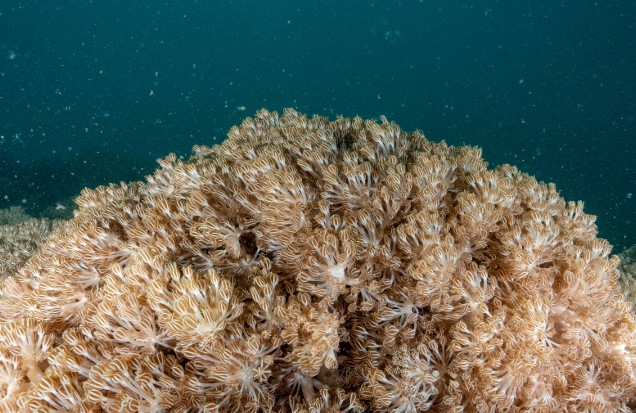Unomia stolonifera
Unomia stolonifera
- Regulatory Status: Any import of this species without a permit from HDOA is illegal.
- What You Can Do: Participate in the don’t let it loose campaign. Dispose of aquarium plants property if you need to move or relocate and can’t bring your aquarium with you. Report invasive aquatic species you find.
- Distribution: 80 acres of this species were discovered in Pearl Harbor in 2023. It now covers upwards of 100 acres.

Unomia stolonifera
Photo credit above: DLNR
DESCRIPTION:
- “Unomia stolonifera, (formerly Xenia sp.) commonly known as the “stoloniferous fire coral”, is a fast-growing soft coral that originates from the Indo-Pacific region. It is known for its ability to reproduce quickly and outcompete native corals, ultimately smothering and displacing them.” (ICRI)
- “Unomia stolonifera forms very soft colonies up to 9 cm high and 6 cm wide. The soft coral is characterized by its white-pink coloring and is known for its dance-like movements in the ocean currents.” (reeflex.net)
- “The polyp body is up to 25 mm long, the tentacles are up to 10 mm long and bear leaflets arranged in three rows, with 20-25 leaflets in the outermost row and a gap of up to one leaflet width between adjacent leaflets.” (reeflex.net)
- This species spreads through fragments which can be spread by boats and floating objects. Once re-attached it can grow on almost anything. (CNRH)
IMPACTS:
- Kills off native corals by smothering growth behavior.
- Death of reef from smothering leads to drastic decrease in fish stocks.
- The species has a strong rotten fish smell, and when widespread the smell will begin to spread to fish living in the area. (Washington Post)
- Coral smell and appearance has negative affect on tourism, by decimating fish stocks, killing coral, and due to its unpleasant smell and feel.
- In Venezuela, the invasive coral has spread to over an 1000 square foot radius, where all of the impacts above have made an enormous impact on coastal livelihoods, lifestyles and the economy.
- Fisherman in Venezuela report that last year was one of their worst catches on record. Israel Sosa, a longtime fisherman in these waters, says his haul has dropped from about 33,000 pounds of Albacore fish in a 48-hour shift just a few years ago to closer to 220 pounds. (Washington Post)
ERADICATION & CONTROL METHODS:,
- Hand removal can be a slow-going, but successful way to remove this species. Caution must be taken not to spread fragments, which can re-establish themselves and colonize new areas.
- Tarping can be used to slow the spread of the coral.
- Tarps, sandbags and bleach can be used to starve the corals of oxygen, which jumpstarts decomposition. (SAME)
- A novel technique to dispose of the coral has been being used in Venezuela. An ultrasound gun is used to cut through the coral, which is then sucked up by a machine and disposed of. (Washington Post)
WHAT YOU CAN DO:
- Properly dispose of aquatic plants when you can no longer keep them. (Seal aquatic plants in plastic bags and dispose in the trash.)
- Comply with to signs to not fish in areas where recreation is restricted due to Unomia presence.
- Report any Unomia seen in new areas to Division of Aquatic Resources.
- Never dump species into the ocean, rivers or natural bodies of water. Contact local aquarium shops for assistance with rehoming.
For more information
- Don’t Let it Loose!
- Report an Aquatic Invasive Species
- Marine Aquatic Invasive Species (AIS) in Hawaiʻi – (Bishop Museum)
- Protecting Pearl Harbor’s Marine Environment From Aquatic Invasive Species
- Navy Partners with State and Federal Agencies to Stop Invasive Species
- Navy Works with Local Partners to Eradicate Invasive Species
- Navy works to stop 2 aquatic invasive species
- Unomia stolonifera smothers Venezuelan reefs
- Why some corals are better off dead
- How Are These Invasive Soft Corals Choking Venezuela’s Reefs?